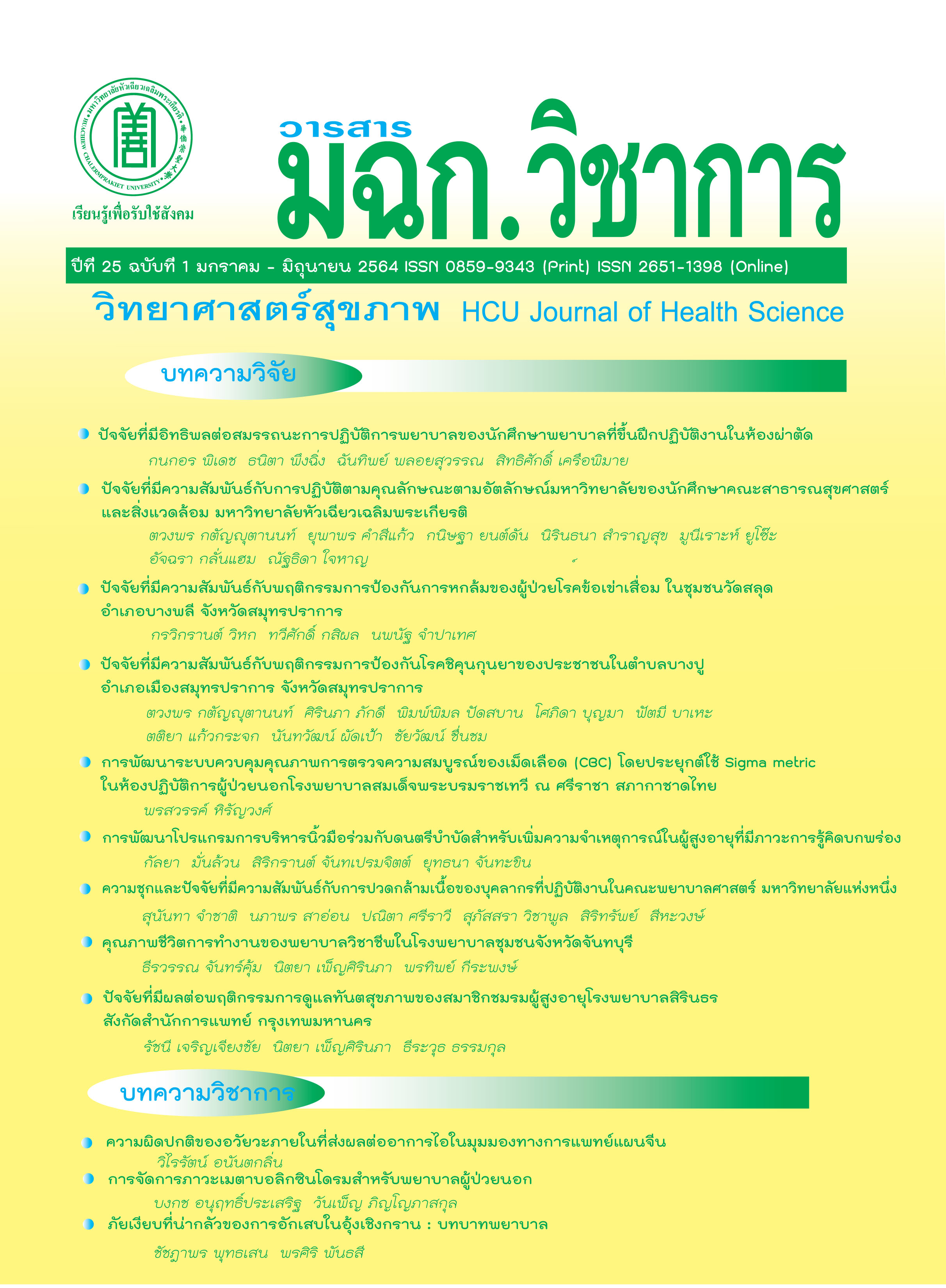การวินิจฉัยและแก้ไขปัญหาสุขภาพชุมชนโดยเน้นการมีส่วนร่วมของชุมชน ตำบลนางแล จังหวัดเชียงราย
คำสำคัญ:
การวินิจฉัยปัญหาสุขภาพชุมชน, การแก้ไขปัญหาสุขภาพชุมชน, การมีส่วนร่วมของชุมชนบทคัดย่อ
การวิจัยเชิงปฏิบัติการแบบมีส่วนร่วมมีวัตถุประสงค์เพื่อศึกษาภาวะสุขภาพ วินิจฉัยและแก้ไขปัญหาสุขภาพชุมชนโดยเน้นการมีส่วนร่วมของชุมชน ตำบลนางแล จังหวัดเชียงราย มีวิธีการเก็บข้อมูล 2 วิธี ได้แก่ 1) การเก็บข้อมูลเชิงปริมาณ กลุ่มตัวอย่าง คือ ประชาชน จำนวน 400 คน โดยสุ่มตัวอย่างแบบเป็นระบบ เฉพาะผู้ที่มีอายุ 15-90 ปี เครื่องมือที่ใช้ คือ แบบสอบถาม วิเคราะห์ข้อมูลโดยใช้สถิติเชิงพรรณนา คือ ความถี่ ร้อยละ ค่าเฉลี่ย ส่วนเบี่ยงเบนมาตรฐาน และ 2) การเก็บข้อมูลเชิงคุณภาพ โดยใช้วิธีการจัดเวทีประชาคมและการสนทนากลุ่ม คัดเลือกกลุ่มตัวอย่างโดยพิจารณาจากความสามารถในการสื่อสารภาษาไทยได้เป็นอย่างดีและยินดีให้ความร่วมมือประกอบการเก็บรวบรวมข้อมูล จำนวน 20 คน โดยใช้แบบฟอร์มการจดบันทึกข้อมูล และเครื่องบันทึกเทปการสนทนา วิเคราะห์ข้อมูลโดยการวิเคราะห์เชิงเนื้อหา ผลการวิจัยข้อมูลเชิงปริมาณ พบว่า ปัญหาสุขภาพชุมชนในระดับบุคคล พบ 3 ปัญหา ได้แก่ 1) ปัญหาประชาชนเจ็บป่วยด้วยโรคเรื้อรัง 2) ปัญหาประชาชนมีพฤติกรรมเสี่ยงทางสุขภาพ 3) ปัญหาประชาชนมีความเครียดทำให้ซึมเศร้า ในระดับครอบครัว พบ 2 ปัญหา ได้แก่ 1) ปัญหาครอบครัวที่ไม่มีผู้ดูแล 2) ปัญหามีสิ่งรบกวนในครัวเรือน และในระดับชุมชนพบ 1 ปัญหา ได้แก่ ปัญหาประชาชนขาดการดูแลชุมชน ผลการวิจัยข้อมูลเชิงคุณภาพ พบว่า ชุมชนให้ความสำคัญกับปัญหาที่ต้องร่วมกันแก้ไขเป็นลำดับแรก คือ ปัญหาประชาชนมีพฤติกรรมเสี่ยงทางสุขภาพ ซึ่งทุกปัญหามีความสัมพันธ์กันในเชิงระบบที่ส่งผลกระทบต่อสุขภาพของประชาชน ดังนั้นการมีส่วนร่วมของชุมชนจึงเป็นวิธีการหนึ่งที่เหมาะสมในการแก้ไขปัญหาสุขภาพชุมชน ข้อเสนอแนะจากผลการวิจัย คือ องค์กรปกครองส่วนท้องถิ่นควรนำผลการวิจัยไปใช้ในการจัดทำแผนงานของหน่วยงานโดยบูรณาการการทำงานกับทุกภาคส่วน เช่น โรงพยาบาลส่งเสริมสุขภาพตำบล เพื่อพัฒนาโครงการแก้ปัญหาสุขภาพของประชาชนแบบองค์รวมที่คำนึงถึงความสัมพันธ์ของปัญหาในระดับบุคคล ครอบครัว และชุมชนเพื่อให้ประชาชนมีสุขภาพดี ลดการเจ็บป่วย การตาย ความพิการจากโรคหรือปัญหาสุขภาพที่มีวิธีป้องกันได้
Downloads
เอกสารอ้างอิง
2. ชาย โพธิสิตา. การเปลี่ยนแปลงครอบครัวและครัวเรือนไทย: เรา (ไม่) รู้อะไร?. ประชากรและสังคม; 2554.
3. สุขศิริ ประสมสุข. กระบวนการอนามัยชุมชน. ใน: จริยาวัตร คมพยัคฆ์ และวนิดา ดุรงค์ฤทธิชัย. การพยาบาลอนามัยชุมชนแนวคิดหลักการและการปฏิบัติการพยาบาล. พิมพ์ครั้งที่ 2. กรุงเทพฯ: จุดทองจำกัด; 2554.
4. เดชา ทำดี และ วิลาวัณย์ เตือนราษฎร์. การวินิจฉัยชุมชนและการจัดลำดับความสำคัญของปัญหา. ใน ศิวพร อึ้งวัฒนา และ พรพรรณ ทรัพย์ไพบูลย์กิจ. การพยาบาลชุมชน. พิมพ์ครั้งที่ 1. เชียงใหม่: ครองช่างพริ้นท์ติ้งจำกัด; 2555.
5. พรศิริ พันธสี. กระบวนการพยาบาล&แบบแผนสุขภาพ: การประยุกต์ใช้ทางคลินิก. พิมพ์ครั้งที่ 2. กรุงเทพฯ: พิมอักษร; 2552.
6. กิตติพงศ์ พลเสน, ทัศนีย์ ศิลาวรรณ, อรนุช ภาชื่น, ณิชชาภัทร ขันสาคร. การระบุและสังเคราะห์ปัญหาสุขภาพชุมชนโดยใช้กระบวนการเรียนรู้แบบมีส่วนร่วม. วารสารสาธารณสุขมหาวิทยาลัยบูรพา 2559; 11(2): 22-32.
7. ทัศนีย์ ลักขณาภิชนชัช. การบริหารสังคมเพื่อสร้างความเข้มแข็งของชุมชนเมือง. [อินเทอร์เน็ต]. 2551 [เข้าถึงเมื่อ 5 ตุลาคม 2562]. เข้าถึงได้จาก: http://www.thaingo.org/writer/view.php?id=656
8. Pender NJ. Health Promotion in nursing practice. 2nd Edition, Connecticus: Appleton & Lange; 1987.
9. Yamane T. Statistics: An Introductory Analysis. 3rd Edition, Harper and Row, New York; 1973.
10. กรมสุขภาพจิต. ดัชนีชี้วัดความสุขคนไทยฉบับสั้นใหม่ ปี 2550. [อินเทอร์เน็ต]. 2561 [เข้าถึงเมื่อ 15 มีนาคม 2561]. เข้าถึงได้จาก: https://www.dmh.go.th/test/
11. ธานินทร์ ศิลป์จารุ. การวิจัยและวิเคราะห์ข้อมูลทางสถิติด้วย SPSS. พิมพ์ครั้งที่ 10. กรุงเทพฯ: บิสซิเนสอาร์แอนด์ดี; 2552.
12. ชนินทร์ เจริญกุล. การพัฒนาอนามัยชนบทเบ็ดเสร็จ. นครราชสีมา: โคราชไทยรุ่งเรืองกิจการพิมพ์; 2551.
13. เรมวล นันท์ศุภวัฒน์ และคณะ. การพัฒนาระบบสุขภาพชุมชน โดยชุมชน เพื่อชุมชน: กรณีศึกษาชุมชนตำบลไชยสถาน. พยาบาลสาร 2555; 39(2): 144-154.
14. สำนักโรคไม่ติดต่อ. ข้อมูลโรคไม่ติดต่อเรื้อรัง. [อินเทอร์เน็ต]. 2562 [เข้าถึงเมื่อ 6 ตุลาคม 2562]. เข้าถึงได้จาก: http://thaincd.com/information-statistic/non-communicabledisease-data.php
15. วาทกานต์ ช่อแก้ว. การประกอบอาชีพและการมีรายได้ของชาวชนบทไทย. ศูนย์ข้อมูลเพื่อการพัฒนาชนบท กรมการพัฒนาชุมชน กระทรวงมหาดไทย; 2555.
16. Epstein TS, Jezeph D. Development -There is Another Way: A Rural – Urban Partnership Development Paradigm. World Development 2001; 29(11): 43-54.
17. เพ็ญจันทร์ สิทธิปรีชาชาญ และปนัดดา ปริยฑฤฆ. กระบวนการพัฒนาระบบการดูแลสุขภาพชุมชน: 14 กรณีศึกษาในชุมชนพื้นที่ภาคกลาง. วารสารพยาบาลสาธารณสุข 2557; 28(1): 1-15.
ดาวน์โหลด
เผยแพร่แล้ว
รูปแบบการอ้างอิง
ฉบับ
ประเภทบทความ
สัญญาอนุญาต
บทความที่ได้รับการตีพิมพ์เป็นลิขสิทธิ์ของวารสารวิทยาศาสตร์สุขภาพและสุขภาวะ
ข้อความที่ปรากฏในบทความแต่ละเรื่องในวารสารวิชาการเล่มนี้เป็นความคิดเห็นส่วนตัวของผู้เขียนแต่ละท่านไม่เกี่ยวข้องกับมหาวิทยาลัยหัวเฉียวเฉลิมพระเกียรติ และคณาจารย์ท่านอื่นๆในมหาวิทยาลัยฯ แต่อย่างใด ความรับผิดชอบองค์ประกอบทั้งหมดของบทความแต่ละเรื่องเป็นของผู้เขียนแต่ละท่าน หากมีความผิดพลาดใดๆ ผู้เขียนแต่ละท่านจะรับผิดชอบบทความของตนเองแต่ผู้เดียว




